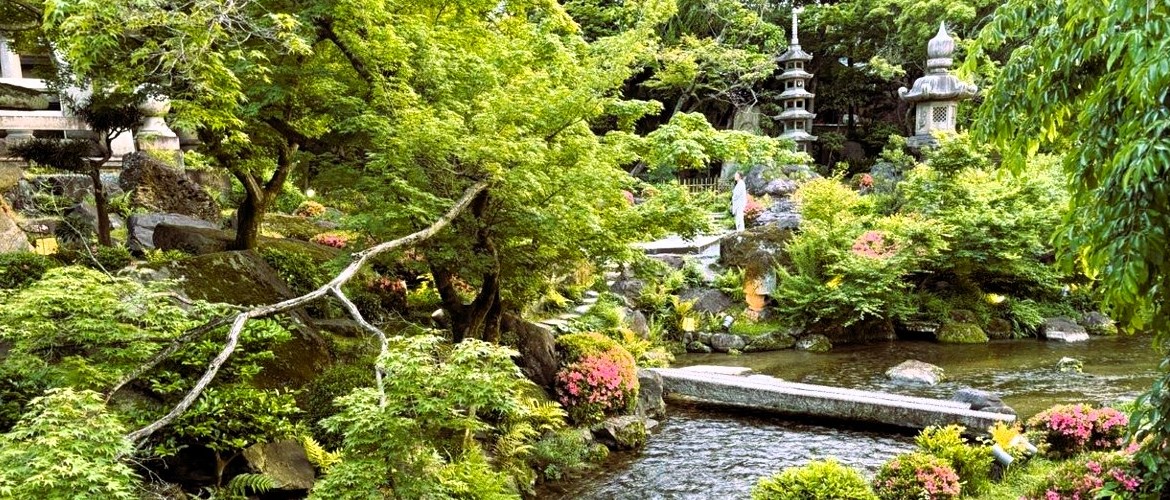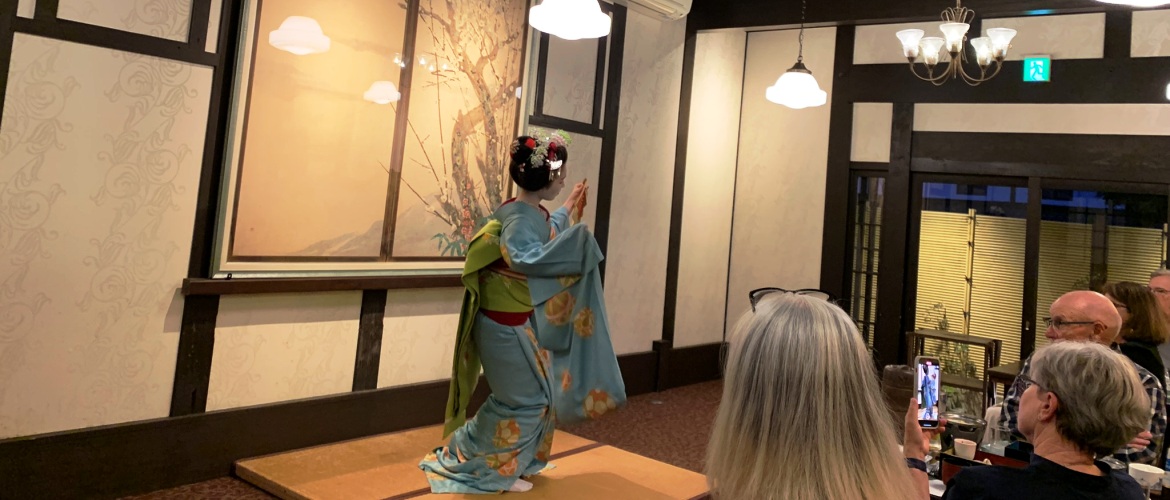Tokyo – Mt. Fuji – Hakone – Kanazawa – Takayama – Shirakawa-go – Kyoto – Nara – Osaka
Join us on this exquisite small group tour through the heart of Japan, where ancient traditions gracefully dance alongside the vibrant rhythm of modernity. In dynamic Tokyo and Osaka, neon lights and bustling energy of urban life pulse with the beat of contemporary Japan. As we wander through the poetic streets of Kyoto, where cherry blossoms and autumn leaves whisper tales of ancient elegance, we find ourselves embraced by the essence of a bygone era. In the ancient capital of Nara, sacred deer roam freely. Chances are, until now, you haven’t heard much about the romantic city of Kanazawa and the mountain town called Takayama. Now is the time to go find out why they are becoming so popular among overseas visitors.
Important Features
- Small group size (average 15, maximum 20).
- Expert tour leader and local guide(s).
- Premium hotels.
- High-quality local and Western cuisines.
- No shopping stops.
- Sushi making lesson.
- Kaiseki dinner featuring geisha dancer (maiko) performance.
Meal Code: B = breakfast / L = lunch / D = dinner
Day 1/Mon: Departing Home City
The journey begins with your transpacific flight departing from a city of your choice. You’ll lose a day upon crossing the International Date Line.
Day 2/Tue: Arrival in Tokyo
Welcome to Tokyo!
Please make your way to the hotel on your own. Detailed up-to-date information on how to get to the hotel will be provided in the final update two weeks before departure. Private transfer can be arranged on request.
Day 3/Wed: Tokyo (B/L/D)
Tokyo, literally meaning “eastern capital” and officially named Tokyo Metropolis, is one of the most populous mega-cities in the world with a population of 14 million. Formerly known as Edo, the city has been the de facto seat of the Japanese government since 1603 when shogun Tokugawa Ieyasu chose the city for his headquarters. The shogun (general) was a hereditary commander ceremoniously appointed by the emperor but held real power over the country during the shogunate period between 1192 and 1867. Edo was renamed Tokyo after Emperor Meiji moved his seat from Kyoto in 1868 when the last shogun was forced to return power to the imperial court. The city covers an area of 2,187 square kilometres following the merger in 1943 of the city of Tokyo and Tokyo Prefecture.
Our full-day sightseeing begins at the plaza in front of the Imperial Palace. A stroll across the plaza accompanied by commentaries on the imperial family and the history of Tokyo gets the tour off to a good start.
We then proceed to Senso-ji, the oldest Buddhist temple in Tokyo dating back to 628.
After lunch, we drive through the ritzy Ginza shopping district on the way to Meiji Jingu, a Shinto shrine dedicated to Emperor Meiji (1852 -1912) and his wife.
We end the day with a visit to the observation deck atop the Tokyo Metropolitan Government Building in Shinjuku. On a clear day, the visitor could see the peak of Mount Fuji which is located about 84 km to the west. The building complex completed in 1990 at a cost of US$1 billion consists of three main structures each taking up a city block. The architect of the Tokyo Metropolitan Government Building is Kenzo Tange (1913 – 2005), who in 1987 became the first Japanese to win the Pritzker Prize for Architecture.
Welcome dinner features premium Japanese beef.
Day 4/Thu: Tokyo – Mt. Fuji – Hakone – Tokyo (B/L)
We depart at 7:45 AM for a full-day excursion to Mt Fuji and Hakone.
Mt. Fuji, the highest mountain (3,776 metres) in Japan, is a two-hour drive from Tokyo. We stop by the Fujisan World Heritage Center to view the summit and learn about the history, formation and ecology of Mt. Fuji through exhibits and a short film. However, it is purely a matter of luck whether the summit is visible as Mt. Fuji is often shrouded in clouds. Our schedule does not include hiking the mountain – the trails are open between July and early September and it would take the average person at least six hours to hike to the summit even if one starts from the highest station at 2,305 metres above sea level.
We then proceed to Lake Ashi in Hakone for a half-hour cruise across the pristine alpine lake. This is followed by a 10-minute cable car ride that transports us to the station overlooking the sulphur-spewing Owakudani Geothermal Valley. On a clear day, the cable car ride provides stunning views of Mt. Fuji and its surrounding mountain slopes.
We expect to arrive back at the hotel around 6:00 PM.
Day 5/Fri: Tokyo – Kanazawa (B)
Enjoy some downtime before boarding the high-speed train (Hakutaka #561, 11:24/14:17) to Kanazawa. Be sure to grab some snacks for lunch before getting on the train.
On the shores of the Sea of Japan, Kanazawa is the capital of Ishikawa Prefecture. The city has a population of 466,000 and is considered a jewel of Japanese tourism that is often overlooked by foreign tourists due to its relatively remote location. Travellers coming here are richly rewarded with the well-preserved Edo-period city, where the samurai, merchants, geisha, and daimyo (lords) all left their mark.
Due to the proximity of the attractions, our sightseeing in Kanazawa is done exclusively on foot with occasional use of taxi to cover the short distances between some of the locations. Please expect to walk 5 to 8 km per day.
After hotel check-in, we walk, or go by taxi (2 km, 6 minutes) if the weather is rainy, to Higashi Chaya district. This is one of the three preserved historical geisha districts in Kanazawa (along with Nishichayagai and Kazuemachi) where geisha still entertain today.
Day 6/Sat: Kanazawa (B/L)
Today’s sightseeing on foot begins at Omicho Market, Kanazawa’s largest fresh food market particularly well known for seafood.
From the market, Kanazawa Castle is just a few minutes away on foot. The restored castle was originally built in 1580 for Maeda Toshiie, the fourth son of a minor samurai who entered the service of a powerful daimyo at the age of 15 and quickly rose through the ranks. The castle was reconstructed multiple times due to fire damages throughout its history. The last time a fire destroyed the castle was in 1881.
The Hishi Yagura turret, Gojikken Nagaya warehouse and the Hashizume-mon Tsuzuki Yagura turret were faithfully restored in 2001 to their 1809 form using traditional construction methods. Today’s pillars are constructed from the Japanese Hinoki cypress along with the use of the massive American cypress as ceiling beams. The reconstructed buildings feature roof tiles made of lead mixed with a little copper for the sake of durability and aesthetics.
From the castle, we walk across a bridge to enter Kenroku-en, which used to be part of the castle. One of the “Three Great Gardens of Japan” (Koraku-en in Okayama and Kairaku-en in Mito being the other two), Kenroku-en was developed from the 1620s to the 1840s by the Maeda clan, the daimyo that ruled the former Kaga Domain.
The restaurant for lunch is a 12-minute walk (700 metres) from the garden.
After lunch, we walk across the street to enter Nagamachi, a historical preservation zone where the residents still go about their daily lives among the remnants of a bygone age. A highlight of the neighbourhood is the restored Nomura Samurai House, whose small but supremely exquisite traditional garden delights visitors from around the world.
Guests who are tired of walking can go back to the hotel from the samurai house by taxi (1.4 km) for about 1,000 yen (equivalent to 7 US dollars).
Day 7/Sun: Kanazawa – Takayama – Shirakawa-go – Kanazawa (B/L)
We set out at 7:40 for a full-day excursion to Takayama and Shirakawa-go.
Famous for its inns, sake breweries, food festivals and local folk art, Takayama (118 km southeast of Kanazawa) is a delightful town nestled amongst the Japanese Alps. Our sightseeing here takes in an open-air market, Sanmachi Historic District, and Takayama Jin’ya – the government house of the region during the Tokugawa shogunate period.
After lunch, we travel northbound in the direction of Kanazawa to visit Shirakawa-go. Situated in a picturesque river valley, Shirakawa-go is part of the UNESCO World Heritage Site known as Historic Villages of Shirakawa-go and Gokayama. The village’s gassho-style large houses with steeply pitched thatched roofs are said to be the only surviving examples of their kind in Japan.
Day 8/Mon: Kanazawa – Kyoto (B/L/D)
This morning we ride the express train (Tsurugi 15, 09:54/10:36; Thunderbird #16, 10:40/11:39) to Kyoto.
Nicknamed “City of Ten Thousand Shrines”, Kyoto (literal translation: capital city) served as Japan’s capital for more than one thousand years before the imperial court moved to Tokyo in 1868 with the onset of the Meiji Restoration (1868 to 1912, a historical period associated with the emergence of Japan as a modernized nation). Kyoto is a scaled replica of the Chinese Tang Dynasty’s capital Chang’an, present-day Xi’an. The Tang Dynasty (618 – 907) was a golden era in Chinese history and a time when Japanese adoption of Chinese culture reached its peak. Kyoto today, with a population of 1.46 million, forms a major part of the Kyoto-Osaka-Kobe metropolitan area.
Our first stop after lunch is Kinkaku-ji (Temple of Golden Pavilion). This is a Zen Buddhist temple and one of 17 locations comprising the Historic Monuments of Ancient Kyoto World Heritage Site.
We then proceed to the Arashiyama (Storm Mountain) area where our sightseeing takes in Tenryu-ji Temple and the Bamboo Forest. Located on the western outskirts of Kyoto, Arashiyama is famous for its immense natural beauty as well as its historical and cultural prominence due to the large number of well-preserved ancient Buddhist temples.
Afterwards, we return to the hotel to freshen up before heading out for a traditional kaiseki dinner accompanied by the private performance of a dancing geisha known as maiko in Japanese.
Day 9/Tue: Kyoto (B)
This morning’s walking tour begins at the magnificent Higashi Hongan-ji, an 800-metre (15 minutes) walk from the hotel. Higashi Hongan-ji is a Buddhist temple whose name means “the Eastern Monastery of the Original Vow”. The temple was first established in 1602 by the shōgun Tokugawa Ieyasu when he split the Jodo Shinshu (True Pure Land), also known as Shin Buddhism, in two (Nishi Honganji being the other) in order to diminish its power.
At the center of the temple is the Founder’s Hall, where an image of the temple’s founder, Shinran, is enshrined. The hall is one of the largest wooden structures in the world at 76 m (250 ft.) in length, 58 m (190 ft.) in width, and 38 m (125 ft.) in height. The current hall was constructed in 1895 after it was burned down in 1864 during the Kinmon Incident.
We then take the subway (3 stops) to magnificent Nijo Castle. Construction of the castle began in 1601 under the order of Tokugawa Ieyasu, founder of the Tokugawa shogunate, but was not completed until 1626 during the reign of Iemitsu, the third Tokugawa shogun and grandson of Ieyasu. The Tokugawa shogunate was headquartered in Edo, present-day Tokyo, and Nijo Castle was the shogun’s residence in Kyoto where the imperial court was located. Nijo Castle is also the site that witnessed the ending of the Tokugawa shogunate. In late 1867, the last shogun, Yoshinobu, announced in the castle his decision to return his power back to the emperor. This was a watershed moment that helped usher in the Meiji Restoration, which, in turn, led to Japan’s industrialization and fundamentally transformed the Japanese society.
Afterwards, we return to the hotel by subway (3 stops) for a break.
The afternoon walking tour takes in the famous Gion district, the birthplace of the geisha culture. The 2-kilometre walk from the hotel is on flat ground and takes about 25 to 30 minutes.
Day 10/Wed: Kyoto (B)
Today is set aside for you to explore on your own.
Our recommendations include Kiyomizu-dera (Buddhist temple), Kyoto Imperial Palace, Fushimi Inari Shrine (good for hiking), Ginkaku-ji (Silver Pavilion Temple), and Kyoto National Museum.
Day 11/Thu: Kyoto – Nara – Osaka (B/L)
We depart for Nara at 07:45. The 45 km drive to the magnificent Todai-ji temple takes about an hour. This ancient Buddhist temple is well-known not only for its splendid architecture and the huge bronze statue of the Buddha in the main hall but also for the 1,200 wild deer roaming freely on the grounds of the temple.
Nara is the capital city of Nara Prefecture and a former capital of Japan (710 – 794). With a population of roughly 370,000 and an area of 280 square kilometres, the city occupies the northern part of Nara Prefecture. Eight temples, shrines and ruins together with Kasugayama Primeval Forest collectively form “The Historic Monuments of Ancient Nara” – a UNESCO World Heritage Site.
Afterwards, we continue on to Osaka, where we visit the historic Osaka Castle and Osaka’s legendary shopping and entertainment district known as Dotonbori. Situated at the mouth of the Yodo River on Osaka Bay, Osaka is Japan’s third most populous city (after Tokyo and Yokohama) and plays a significant role in the Japanese economy. Osaka was once known as the “nation’s kitchen” because of its function as Japan’s rice trading centre during the Edo period.
Day 12/Fri: Osaka – Return Home (B)
The tour ends this morning. Transfer to the airport on your own by airport limousine bus or airport express train. Detailed advice will be provided in the finalized itinerary.
Hotel List
Hotels are subject to change without notice. Any substitution made would be of equal or higher quality in similar location.
| City | Nights | Hotel | Category |
| Tokyo | 3 | Tokyo Dome Hotel | Premium /4 stars |
| Kanazawa | 3 | Mitsui Garden Kanazawa | Premium /4 stars |
| Kyoto | 3 | Hilton Garden Inn Kyoto Shijo Karasuma | Premium /4 stars |
| Osaka | 1 | Courtyard Shin-Osaka | Premium /4 stars |
Dates and Prices
Prices are per person based on double occupancy.
| Depart (Mon) |
Return (Fri) |
Land Only* CA$/US$ |
Single Supplement** CA$/US$ |
| 2025 | |||
| (Mon) | (Fri) | CA$/US$ | CA$/US$ |
| 16-Jun | 27-Jun | $6,548/$4,675 | $2,295/$1,640 |
| 06-Oct | 17-Oct | $6,850/$4,890 | $2,625/$1,875 |
| 13-Oct | 24-Oct | $6,850/$4,890 | $2,625/$1,875 |
| 20-Oct | 31-Oct | $6,850/$4,890 | $2,625/$1,875 |
| 03-Nov | 14-Nov | $6,930/$4,950 | $2,970/$2,120 |
| 10-Nov | 21-Nov | $6,930/$4,950 | $2,970/$2,120 |
| 17-Nov | 28-Nov | $6,930/$4,950 | $2,970/$2,120 |
| 2026 | |||
| 23-Mar | 03-Apr | $6,930/$4,950 | $2,660/$1,900 |
| 30-Mar | 10-Apr | $6,930/$4,950 | $2,660/$1,900 |
| 13-Apr | 24-Apr | $6,720/$4,800 | $2,660/$1,900 |
| 11-May | 22-May | $6,570/$4,695 | $2,520/$1,800 |
| 18-May | 29-May | $6,570/$4,695 | $2,520/$1,800 |
* Land Only price does not include international air. Contact us for a fare quote.
** Discount available subject to certain conditions. Please contact us for details.
|
Tour price includes:
|
Tour price does NOT include:
See Terms & Conditions for more information. |
Passport & Visa
Your passport needs to have at least one blank visa page and six months validity at the end of the tour.
If you are a tourist from Canada, the US, the UK, Australia and New Zealand, you do not need a visa to enter Japan as long as your stay is within 90 days.
Vaccination
No vaccination of any kind is mandatory. Vaccination against hepatitis A is highly recommended.
Travel Insurance – When to Buy
Your deposit will be kept as credit if you cancel for any reason. The transferrable credit has no expiration date. Therefore, it may be unnecessary to spend $30 to $50 on cancellation insurance just to protect the deposit.
However, purchase of trip cancellation & emergency medical insurance is strongly advised when your balance is due. If you don’t have proper coverage, the loss can be devastating in case of cancellation before or after commencement of the booked trip or in case of a serious medical emergency during the trip. Please ask us for premium quotes when your balance due date is near.





